Focus
First-anniversary highlights
April 2010 marks the first anniversary of the launch of Nature Chemistry. To celebrate, we have put together a compilation of our favourite articles from the first 12 issues. The selection, which is free until the end of June 2010, reflects the breadth of topics covered by Nature Chemistry. We hope you enjoy it.
April 2009
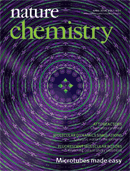
Commentary:
Chemistry goes global in the virtual world
Jeffrey S. Moore & Philip A. Janowicz
Online courses administered by the University of Illinois at Urbana-Champaign show that it is possible to create an effective network of professors and students from across institutional and national borders all learning together — even in conceptually challenging subjects such as organic chemistry.
Feature:
The future of chemistry
Ryoji Noyori, Harry B. Gray, Mark A. Johnson, Barbara Imperiali, Gary M. Hieftje, James H. Clark, Achim Müller & J. Fraser Stoddart
Eight leading chemists with a broad spectrum of interests look to the future and share their vision for how their own fields may develop in the coming years.
Review:
Towards the computational design of solid catalysts
J. K. Nørskov, T. Bligaard, J. Rossmeisl & C. H. Christensen
Advances in computational methods have enabled the trends in reactivity for transition metal and alloy catalysts to be described theoretically. This review discusses some of the first examples of how such knowledge can be used to design solid catalysts.
May 2009
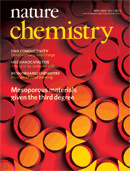
Article:
A tri-continuous mesoporous material with a silica pore wall following a hexagonal minimal surface
Yu Han, Daliang Zhang, Leng Leng Chng, Junliang Sun, Lan Zhao, Xiaodong Zou & Jackie Y. Ying
Porous materials with very different pore sizes and structures are commonly used for various applications. But although bicontinuous pore networks — with two interwoven yet unconnected channels — have been reported, tricontinuous structures have so far only been predicted theoretically. Now, researchers have prepared a mesoporous silica with three identical, interpenetrating channels.
June 2009
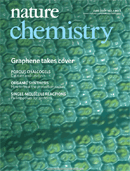
Review:
Protecting-group-free synthesis as an opportunity for invention
Ian S. Young & Phil S. Baran
The use of protecting groups has been, and remains, instrumental in the development of organic synthesis. However, designing protecting-group-free strategies offers the challenge of developing useful new chemoselective processes as well as being inherently more step- and atom-economic.
July 2009
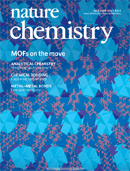
Article:
Amyloid-β protein oligomerization and the importance of tetramers and dodecamers in the aetiology of Alzheimer's disease
Summer L. Bernstein, Nicholas F. Dupuis, Noel D. Lazo, Thomas Wyttenbach, Margaret M. Condron, Gal Bitan, David B. Teplow, Joan-Emma Shea, Brandon T. Ruotolo, Carol V. Robinson & Michael T. Bowers
Ion-mobility mass spectrometry has been used to identify and characterize the oligomeric assemblies of amyloid-β proteins under physiologically relevant conditions. Hexamers and dodecamers are formed only from Aβ42 proteins and the dodecamer is identified as a candidate for the primary toxic agent in the development of Alzheimer's disease.
August 2009
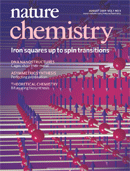
Review:
Enantioselective protonation
Justin T. Mohr, Allen Y. Hong & Brian M. Stoltz
Chemical methods of achieving asymmetric protonation are classified according to reaction mechanism, with a view to developing a greater understanding of this most fundamental of asymmetric processes, and thus improving the potential for its application in synthesis.
September 2009
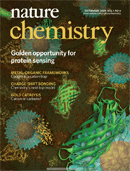
Article:
A bonding model for gold(I) carbene complexes
Diego Benitez, Nathan D. Shapiro, Ekaterina Tkatchouk, Yiming Wang, William A. Goddard, III & F. Dean Toste
An analysis of key intermediates relevant to gold(I) catalysis has been performed using density functional theory. A bonding model is proposed whereby the reactivity of gold(I)-coordinated carbenes is dependent on carbene substituents and ancillary ligands that dictate where these gold structures lie on a continuum ranging from a metal-stabilized singlet carbene to a metal-coordinated carbocation.
October 2009
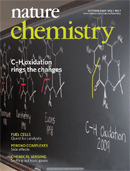
Review:
Ultrashort metal–metal distances and extreme bond orders
Frank R. Wagner, Awal Noor & Rhett Kempe
Transition metals can form extremely short bonds with very high bond orders. Bimetallic chromium complexes are the best-known examples, and quintuple bonds have been reported. This Review covers recent developments in the synthesis and theoretical description of quintuply bonded transition metal coordination compounds.
November 2009
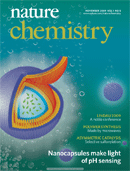
Article:
Vesicular perylene dye nanocapsules as supramolecular fluorescent pH sensor systems
Xin Zhang, Stefanie Rehm, Marina M. Safont-Sempere & Frank Würthner
Artificial vesicles consisting of encapsulated fluorescence resonance energy transfer (FRET)-donor molecules and a FRET-acceptor bilayer dye-membrane provide ultrasensitive pH information in aqueous media by displaying pH-dependent fluorescence colour covering the entire visible light range. An exceptional white fluorescence was observed at pH 9.
News & Views:
Molecular imaging: The tip of what can be seen
Neil R. Champness
Chemists have long relied on techniques that give indirect hints and clues as to the structure of the molecules they study, but advances in scanning probe microscopy provide a glimpse of the individual atoms and bonds within pentacene.
December 2009
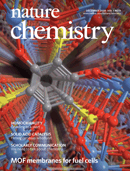
Article:
Type-zero copper proteins
Kyle M. Lancaster, Serena DeBeer George, Keiko Yokoyama, John H. Richards & Harry B. Gray
Copper-containing proteins can be classified into types 1 and 2, depending on their functional or spectroscopic properties. Now, a protein that fits neither type has been built using a scaffold made from the protein Pseudomonas aeruginosa azurin.
Commentary:
Communicating chemistry
Theresa Velden & Carl Lagoze
New web-based models of scholarly communication have made a significant impact in some scientific disciplines, but chemistry is not one of them. What has prevented the widespread adoption of these developments by chemists — and what are the prospects for adoption over time?
January 2010
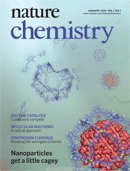
Article:
Dinitrogen cleavage and functionalization by carbon monoxide promoted by a hafnium complex
Donald J. Knobloch, Emil Lobkovsky & Paul J. Chirik
Two abundant feedstocks, dinitrogen and carbon monoxide, have the strongest bonds in chemistry, so breaking them is a significant challenge. An organometallic hafnium compound has now been shown to induce nitrogen cleavage on addition of carbon monoxide, with simultaneous assembly of new nitrogen–carbon and carbon–carbon bonds.
February 2010
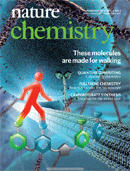
Article:
Towards quantum chemistry on a quantum computer
B. P. Lanyon, J. D. Whitfield, G. G. Gillett, M. E. Goggin, M. P. Almeida, I. Kassal, J. D. Biamonte, M. Mohseni, B. J. Powell, M. Barbieri, A. Aspuru-Guzik & A. G. White
Precise calculations of molecular properties from first-principles set great problems for large systems because their conventional computational cost increases exponentially with size. Quantum computing offers an alternative, and here the H2 potential energy curve is calculated using the latest photonic quantum computer technology.
March 2010
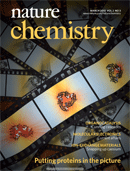
Article:
Watching conformational and photodynamics of single fluorescent proteins in solution
Randall H. Goldsmith & W. E. Moerner
A method for observing the photodynamics of single molecules, without having to immobilize them to a surface or confine them within vesicles, has been used to study the important photosynthetic antenna protein, allophycocyanin. Light-induced conformational changes and a complex relationship between fluorescence intensity and lifetime have been observed.
News & Views:
Single-molecule spectroscopy: Caught in a trap
Peter Dedecker & Johan Hofkens
Monitoring the dynamics of a single molecule is impeded by their motion in solution, and immobilizing them without changing their properties is problematic. By using a trapping method that counteracts a molecule's Brownian motion, the complex dynamics of a fluorescent protein, allophycocyanin, have been investigated.
